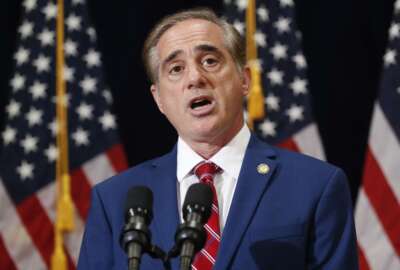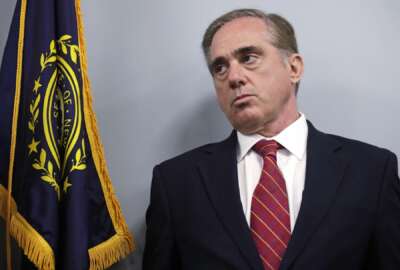

Veterans Affairs Secretary David Shulkin gave a progress report on a wide range of initiatives. He told the Senate VA Committee that the department is still making...
Subscribe to Federal Drive’s daily audio interviews on iTunes or PodcastOne.
Vacancies —at least 35,000 health care professionals and four key leadership positions — are holding the Veterans Affairs Department back from true progress.
That’s the message VA Secretary David Shulkin took to Congress Wednesday, as he detailed the status of several major initiatives that the department’s attempting to move on at breakneck speed.
VA has been without a permanent undersecretary for benefits for more than 825 days, since October 2015.
The department had a candidate for its benefits undersecretary. By law, VA is required to gather a commission to offer and make official suggestions with three candidates to send to the president. The department made its top choice, but the candidate withdrew from consideration, Shulkin said. VA is pursuing its second choice, who is also going through the White House vetting process.
VA has lacked a chief information officer for 362 days. The department picked a candidate for its CIO position, which is going through the White House vetting process now, Shulkin said.
The VA undersecretary for health position has been open for 337 days.
The department will hold its third commission to find candidates for the undersecretary for health position, Shulkin’s former job. The first two commissions didn’t bring forth any candidates, but Shulkin said he hopes the third commission will find at least three options out of the 11 candidates who have applied.
A new position, the assistant secretary for accountability and whistleblower protection, has been pending for 208 days.
Without a doubt, 2017 was a busy year for the department. Congress passed new legislation that changed disciplinary procedures for VA employees and senior executives, authorized procedural changes to the lengthy and confusing veterans appeals process and attempted, though unsuccessfully, to navigate a new path forward for the Veterans Choice Program.
“When I look back on this year, we’re still largely managing through incrementalism, patching and repairing old systems and processes and reacting to crises,” Shulkin said. “VA is still far short of the bold, transformational change that we need to serve veterans in the decades ahead.”
From his perspective, VA is still making too many decisions from the central office in Washington, D.C. He reiterated a familiar to desire to hand decision-making authority to VA field offices across the country, a theme that’s becoming a common talking point for secretaries at several federal agencies.
“We need to reorganize the way that we do business at VA, from having a large central bureaucracy to being able to give people in the field more authority and accountability that goes along that way,” Shulkin said. “We need to change some our management practices that, frankly, have grown stale.”
Now nearly one year after his confirmation hearing before the Senate Veterans Affairs Committee, Shulkin offered a progress report that touched on many aspects of the department’s work.
“We are at the time where there are no excuses,” committee Chairman Johnny Iskason (R-Ga.) said during Wednesday’s hearing. “There are no excuses for why we don’t correct the problems we’ve had hiring. There’s no excuse for the problems we’ve had with IT. There’s no excuse for creating the problems we’ve had with appeals and all those areas, so this is all about accountability.”
Both House and Senate VA lawmakers have yet to agree on a path forward for the Veterans Choice Program.
Without consensus at the end of 2017, Congress approved an additional $2.1 billion in Choice funding to keep the program alive and buy more time to develop a legislative solution.
Congress, armed with a legislative proposal from VA itself, has been working on this topic for much of the year. By December, both House and Senate VA committees had passed their own Choice legislation.
And though Republicans and Democrats had been largely working together on different versions of the Choice legislation, both parties broadly agreed on the main policy elements in the bills.
But the challenge of paying for a new VA community care program has stumped both chambers. High Congressional Budget Office scores had forced the House Veterans Affairs Committee, for example, to revisit legislation in progress.
To move the negotiations on, the White House plans to send the committee in the next few days some suggestions for a way to take the Veterans Choice program forward, Iskason said.
Ultimately, the goal is to bring a bill forward to the Senate floor that nearly everyone can agree on, he added.
Shulkin has previously said hiring was the “single most challenging thing ” that he knew of at the department, and many senators were frustrated, if not skeptical, of VA’s struggles to fill critical vacancies.
The department saw a net increase of 8,303 of new employees last year, but VA still has a number of vacancies, Shulkin said. As of last October, VA had 35,345 total full-time equivalent vacancies, the department said.
“What’s the problem? I’ve talked to you many times, I know you’re committed to this, but it seems like it’s getting worse,” committee Ranking Member Jon Tester (D-Mont.) said. “In fact, it doesn’t seem like it. In my state, it’s getting worse.”
The Office of Personnel Management signed off on direct-hire authority for 15 critical positions at VA. The department will begin to act on its new authorities in the next few weeks, Shulkin said.
Shulkin said the department will increase hiring bonuses and education debt reduction incentives for health professionals in Montana, but it’s unclear if those incentives will extend to VA applicants in other states.
VA decided last December it would strategically “pause” the acquisition process for a new electronic health record, according to Shulkin’s written testimony.
“The purpose of the pause is to conduct an additional and external assessment of national interoperability language contained in the request for proposal that would ultimately support an EHR contract award,” Shulkin’s testimony reads.
VA in June announced its plans to adopt MHS Genesis, the same EHR system the Defense Department is already deploying. The Pentagon is implementing the health record to sites in the Pacific Northwest, and VA said it intends to follow DoD’s same deployment path.
VA hasn’t yet announced a final contract with Cerner Corporation, the same vendor behind DoD’s electronic health record. The whole project is expected to take 10 years.
Shulkin at the time said initial contract negotiations with Cerner were expected to take three to six months. In late September, Shulkin said the department had given Congress a 30-day notice of award of a contract.
Now in mid-January, VA is well past the three-to-six month timeline the department had originally given.
VA has asked the MITRE Corporation to coordinate and review the contract language. Clinicians, chief information officers and other IT executives were part of the review held on Jan. 5. MITRE will collect recommendations and comments from the review and is expected to submit a final report by the end of the month.
Shulkin said the pause is a precaution to ensure that VA’s contract will accurately convey the department’s need for interoperability with its community providers.
“I want to make sure that when we sign a contract that will go into place for years and years to come, that we’ve done everything that we can to make sure that veterans have interoperable records,” Shulkin told reporters Wednesday afternoon. “When I’m assured that we can get this to the very best place we can, then I’ll feel more comfortable proceeding. It’s a cautious pause. It shouldn’t be over-interpreted. I’m not satisfied that we have everything that we need so that I know that we’ve done the best job that we can.”
Since the president signed the VA Accountability and Whistleblower Protection Act into law in June, the department has been training its HR managers on the new changes. VA developed four human resources management letters as guidance to HR managers on how they should implement disciplinary provisions.
“Your predecessors have testified the leadership includes working with under-performing employees to make them better at their jobs, rather than just firing them,” Tester said. “Is that your philosophy too?”
Shulkin agreed.
“We have room for improvement, because we you look at our employee engagement scores, they’re not improving that way that I believe that they should, so we’re looking at re-looking at our efforts to do that better,” he said.
VA is piloting a new appeals process, which Congress authorized when it passed the Veterans Appeals Improvement and Modernization Act last year.
“We’ve actually started to make major improvements already,” Shulkin said. “This year, we are on track to do 81,000 appeals, that would be 30,000 more than last year. Right now at this fiscal year, we’re at 21,000 appeals, that’s 10,000 more than this time last year, so we’re getting better and faster, and we’ve brought on new staff.”
About 3 percent of veterans opted into VA’s new appeals process. So far, those veterans have been receiving decisions on their claims within 30 days. Roughly 75 percent of those decisions are leaning in favor of the veteran, Shulkin added.
With a current backlog that stands at 470,000 pending appeals, VA has been looking for any solution that would cut back the time it takes for the department to adjudicate cases.
The department will officially launch the new appeals process in early 2019. That process, however, will only address new appeals that come to VA.
Copyright © 2024 Federal News Network. All rights reserved. This website is not intended for users located within the European Economic Area.
Nicole Ogrysko is a reporter for Federal News Network focusing on the federal workforce and federal pay and benefits.
Follow @nogryskoWFED

 Exclusive
Exclusive 